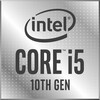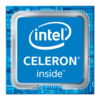Intel Core i5-1035G7 vs Intel Celeron 5305U vs Intel Core i5-1035G4
Intel Core i5-1035G7
► remove from comparison
The Intel Core i5-1035G7 is a power efficient quad-core SoC for laptops and Ultrabooks based on the Ice -Lake-U generation that was announced in Mai 2019 (Computex). It integrates four Sunnycove processor cores (8 threads thanks to HyperThreading) clocked at 1.2 (base) - 3.7 (single core Turbo) GHz. 2 cores can reach 3.6 GHz and all four 3.3 GHz using Turbo Boost. According to Intel the Sunnycove cores achieve 18% more IPCs (Instructions per Clock). The Core i5-1035G7 is the second fastest Ice Lake-U chip at the time of announcement in 2019.
The biggest improvement for Ice-Lake is the integrated Gen 11 graphics adapter called Iris Plus Graphics. The Core i7-1065G7 integrates the biggest G7 variant with 64 CUs clocked at 300 - 1100 MHz. The Iris Plus G7 should be twice as fast as the predecessors and best the AMD Vega 10 GPU in current Ryzen APUs.
Other improvements for Ice Lake are the AI hardware acceleration and the partial integration of Thunderbolt and Wifi 6 in the chip. The integrated DDR4 memory controller supports modules with up to 3200 MHz (and LPDDDR4-3733).
Performance
The average 1035G7 in our database is in the same league as the Ryzen 3 4300U and the Core i5-10210U, as far as multi-thread benchmark scores are concerned. Which isn't bad at all as of late 2021. The Core i5-1035G4 and the Core i5-1035G1 are two other chips that nearly match the 1035G7 in multi-thread performance.
Thanks to its decent cooling solution and a long-term CPU power limit of 22 W, the Surface Laptop 3 13 is among the fastest laptops built around the 1035G7 that we know of. It can be at least 30% faster in CPU-bound workloads than the slowest system featuring the same chip in our database, as of August 2023.
Power consumption
This Core i5 has a default TDP (also known as the long-term power limit) of 15 W, a value that laptop manufacturers are allowed to change to anything between 12 W and 25 W if required with clock speeds and performance changing accordingly. Those values are a little too high to allow for passively cooled designs.
The processor is built with Intel's second-gen 10 nm process for decent, as of late 2022, energy efficiency.
Intel Celeron 5305U
► remove from comparison
The Intel Celeron 5305U is a low-power dual-core SoC for laptops, based on the Comet Lake architecture, which was introduced in 2020. Compared to Kaby Lake and Whiskey Lake, there are apparently no differences with Comet Lake apart from the two additional cores in the Top model Core i7-10710U. The processor is still manufactured using the mature 14nm process (14nm++ like Whiskey Lake). The processor cores clock at a fixed 2.3 GHz (no Turbo) and also only offer 2 threads (no HyperThreading). Compared to the more powerful Core i3, i5 and i7 variants, the Celeron does not offer SSE (2) support.
You can find more information about the Comet Lake architecture and the available processors on our Comet Lake topic page.
According to Intel, the integrated graphics card is called Intel UHD Graphics, but is an old Intel UHD Graphics 610. It is clocked in the Celeron 5205U at 300 - 900 MHz and is only sufficient for very demanding games. The CPU also offers an integrated DDR4-2666 / LPDDR4x 2933 / LPDDR3-2133 dual-channel memory controller as well as VP9 and H.265 video decoder and encoder.
Performance
The performance of the Celeron 5305U is in the lowest entry-level class of notebook processors in 2020. Due to the lack of Turbo and only 2 cores, the CPU cannot score points in either single-core or multi-core tasks. The processor is therefore only suitable for undemanding tasks such as surfing with a few tabs and office tasks.
The power consumption and performance can be set from 15 to 12.5 watts by the notebook manufacturer via cTDP-down. However, the processor then only runs at 800 MHz and significantly reduced performance. Even at 15 watts, however, the processor is suitable for thin and light notebooks.
Intel Core i5-1035G4
► remove from comparison
The Intel Core i5-1035G4 is a low-power, Ice Lake family processor (SoC) featuring 4 cores, 8 threads, 6 MB of L3 cache and the Iris Plus G4 (48 EUs) iGPU. It saw the light of day in H2 2019. The chip is designed for use in highly portable laptops; its CPU cores run at 1.1 GHz to 3.7 GHz, with only 3.3 GHz achievable if all the cores are loaded.
Unlike the costlier Core i5-1035G7, the 1035G4 has the 48 EU Intel iGPU at its disposal as opposed to the more powerful Iris Plus G7 (64 EUs); CPU cores have a slightly lower base clock speed in the case of the 1035G4, too.
Architecture & Features
Ice Lake family chips are powered by Sunny Cove CPU cores.The latter aim to do what Palm Cove cores (that we never really got a chance to get a taste of) were expected to do, delivering a double-digit IPC uplift over the venerable Skylake architecture thanks to a range of small improvements across the board including scheduler improvements, larger caches and buffers, and support for new instruction sets.
Thunderbolt 3 support is built right into the Core i5 (meaning the latter has several PCIe 3 lanes exclusive to Thunderbolt devices, reducing the number of additional components required for Thunderbolt to work) and so is CNVi Wi-Fi 6 support (making it easier for Intel to sell its proprietary WLAN cards to laptop makers). The Core i5-1035G4 also has the DL Boost and GNA features for applications centered around machine learning.
The 4 GT/s bus is indicative of a consumer-grade chip, since CPUs for gaming laptops and portable workstations usually employ the faster 8 GT/s bus. RAM support is nothing to sneeze at, at up to DDR4-3200 or LPDDR4-3733. NVMe SSDs are supported, with data transfer rates limited to 3.9 GB/s (this is what four PCIe 3 lanes are good for). SATA drives and even eMMC chips are also natively supported here.
This is not a user-replaceable CPU, as it gets permanently soldered to the motherboard (BGA1526 socket interface).
OS support is limited to 64-bit Windows 10 and Windows 11, as well as many Linux distros.
Performance
The average 1035G4 in our database is very close to the Ryzen 5 2500U and the Core i5-10310U, as far as multi-thread benchmark scores are concerned. This makes it a mid-range chip, as of late 2021. It can even be used for a bit of gaming if mated to a decent graphics card.
The Acer Spin 3 SP314-54N-56S5 is one of the fastest laptops with this chip that we have tested. Thanks to the power limit 1 of 16.5 W, the Acer can be roughly 30% faster than the slowest system with the 1035G4 we know of, depending on the circumstances.
Graphics
The Iris Plus G4 (48 EUs) runs at up to 1.05 GHz. This is a rather decent iGPU that can be as fast as Nvidia's GeForce MX110 or even MX130, depending on the circumstances. It will handle many games at 1080p or 720p provided one is content with low or medium quality settings, respectively.
This DX12-compatible graphics adapter will drive up to 3 monitors with resolutions as high as 5120 x 3200. There is no support for ray tracing here and no hardware support for the latest AV1 codec; the usual HEVC, AVC and VP9 codecs are supported, thankfully.
Power consumption
This 10th generation Intel Core i5 processor has a default TDP of 15 W (also known as the long-term power limit). Laptop makers are allowed to change that value to anything between 12 W and 25 W, with clock speeds and performance changing accordingly. This means the CPU is too power-hungry to be used as the base of a passively cooled laptop, tablet, mini-PC.
The Core i5-1035G4 is manufactured on Intel's 2nd generation 10 nm process (not "10 nm SuperFin" or "Intel 7") for average energy efficiency, as of early 2023.
| Model | Intel Core i5-1035G7 | Intel Celeron 5305U | Intel Core i5-1035G4 | ||||||||||||||||||||||||||||||||||||||||||||||||||||||||||||||||||||||||||||||||||||||||
| Codename | Ice Lake-U | Comet Lake-U | Ice Lake-U | ||||||||||||||||||||||||||||||||||||||||||||||||||||||||||||||||||||||||||||||||||||||||
| Series | Intel Ice Lake | Intel Comet Lake | Intel Ice Lake | ||||||||||||||||||||||||||||||||||||||||||||||||||||||||||||||||||||||||||||||||||||||||
| Series: Ice Lake Ice Lake-U |
|
|
| ||||||||||||||||||||||||||||||||||||||||||||||||||||||||||||||||||||||||||||||||||||||||
| Clock | 1200 - 3700 MHz | 2300 MHz | 1100 - 3700 MHz | ||||||||||||||||||||||||||||||||||||||||||||||||||||||||||||||||||||||||||||||||||||||||
| L1 Cache | 192 KB | 192 KB | |||||||||||||||||||||||||||||||||||||||||||||||||||||||||||||||||||||||||||||||||||||||||
| L2 Cache | 2 MB | 2 MB | |||||||||||||||||||||||||||||||||||||||||||||||||||||||||||||||||||||||||||||||||||||||||
| L3 Cache | 6 MB | 6 MB | |||||||||||||||||||||||||||||||||||||||||||||||||||||||||||||||||||||||||||||||||||||||||
| Cores / Threads | 4 / 8 | 2 / 2 | 4 / 8 | ||||||||||||||||||||||||||||||||||||||||||||||||||||||||||||||||||||||||||||||||||||||||
| TDP | 15 Watt | 15 Watt | 15 Watt | ||||||||||||||||||||||||||||||||||||||||||||||||||||||||||||||||||||||||||||||||||||||||
| Technology | 10 nm | 14 nm | 10 nm | ||||||||||||||||||||||||||||||||||||||||||||||||||||||||||||||||||||||||||||||||||||||||
| max. Temp. | 100 °C | 100 °C | 100 °C | ||||||||||||||||||||||||||||||||||||||||||||||||||||||||||||||||||||||||||||||||||||||||
| Socket | BGA1526 | BGA1528 | BGA1526 | ||||||||||||||||||||||||||||||||||||||||||||||||||||||||||||||||||||||||||||||||||||||||
| Features | DDR4-3200/LPDDR4-3733 RAM, PCIe 3, 4 GT/s bus, DL Boost, GNA, MMX, SSE, SSE2, SSE3, SSSE3, SSE4.1, SSE4.2, AVX, AVX2, AVX-512, BMI2, ABM, FMA, ADX, VMX, SMEP, SMAP, EIST, TM1, TM2, HT, Turbo, SST, AES-NI, RDRAND, RDSEED, SHA, SGX | LPDDR3-2133/DDR4-2400 RAM, PCIe 2, 4 GT/s bus, MMX, SSE, SSE2, SSE3, SSSE3, SSE4.1, SSE4.2, AVX, AVX2, BMI2, ABM, FMA, ADX, VMX, SMEP, SMAP, MPX, EIST, TM1, TM2, SST, AES-NI, RDRAND, RDSEED, SGX | DDR4-3200/LPDDR4-3733 RAM, PCIe 3, 4 GT/s bus, DL Boost, GNA, MMX, SSE, SSE2, SSE3, SSSE3, SSE4.1, SSE4.2, AVX, AVX2, AVX-512, BMI2, ABM, FMA, ADX, VMX, SMEP, SMAP, EIST, TM1, TM2, Hyper-Threading, Turbo, SST, AES-NI, RDRAND, RDSEED, SHA, SGX | ||||||||||||||||||||||||||||||||||||||||||||||||||||||||||||||||||||||||||||||||||||||||
| iGPU | Intel Iris Plus Graphics G7 (Ice Lake 64 EU) (300 - 1050 MHz) | Intel UHD Graphics 610 (300 - 900 MHz) | Intel Iris Plus Graphics G4 (Ice Lake 48 EU) (300 - 1050 MHz) | ||||||||||||||||||||||||||||||||||||||||||||||||||||||||||||||||||||||||||||||||||||||||
| Architecture | x86 | x86 | x86 | ||||||||||||||||||||||||||||||||||||||||||||||||||||||||||||||||||||||||||||||||||||||||
| Announced | |||||||||||||||||||||||||||||||||||||||||||||||||||||||||||||||||||||||||||||||||||||||||||
| Manufacturer | ark.intel.com | ark.intel.com | ark.intel.com | ||||||||||||||||||||||||||||||||||||||||||||||||||||||||||||||||||||||||||||||||||||||||
| $107 U.S. |
Benchmarks
Average Benchmarks Intel Core i5-1035G7 → 0% n=0
Average Benchmarks Intel Celeron 5305U → 0% n=0
Average Benchmarks Intel Core i5-1035G4 → 0% n=0
* Smaller numbers mean a higher performance
1 This benchmark is not used for the average calculation













